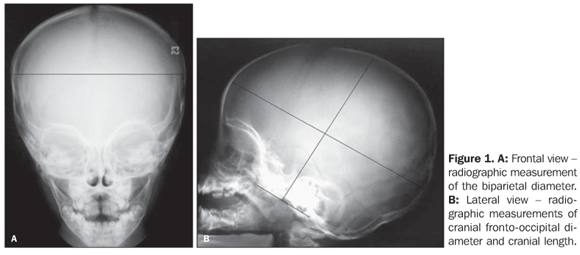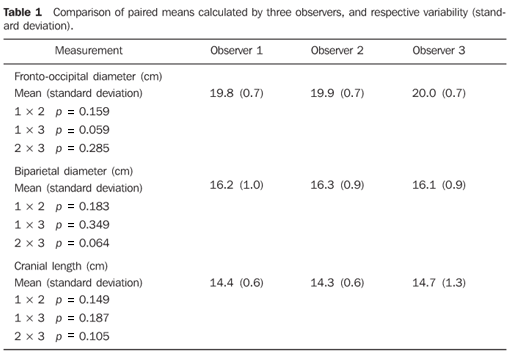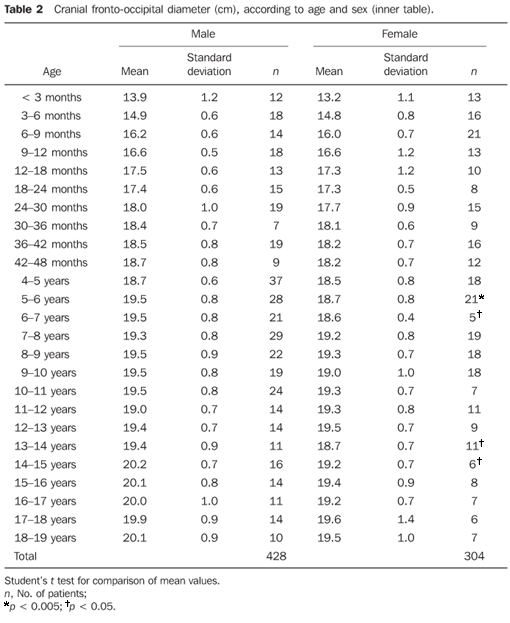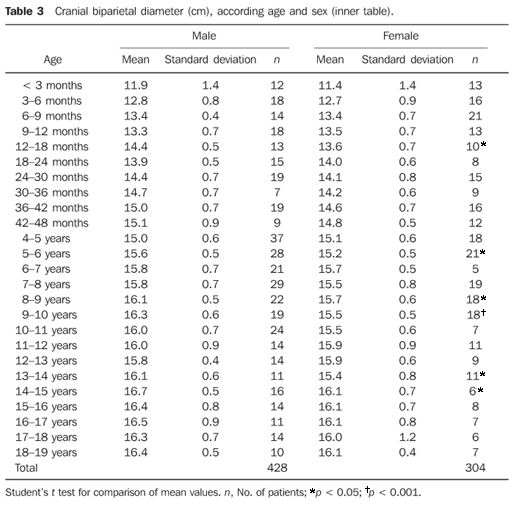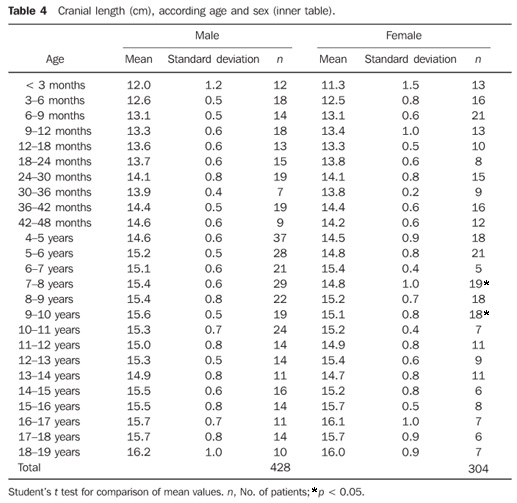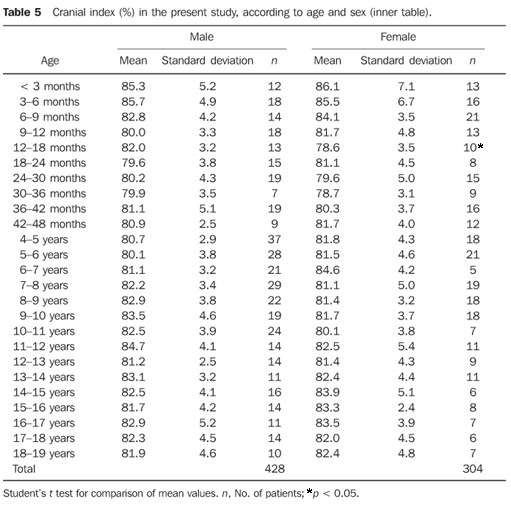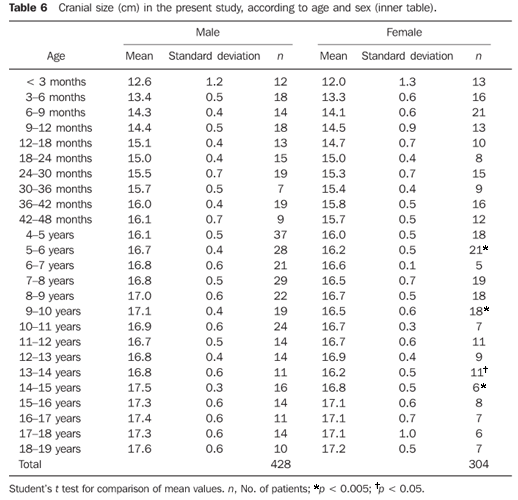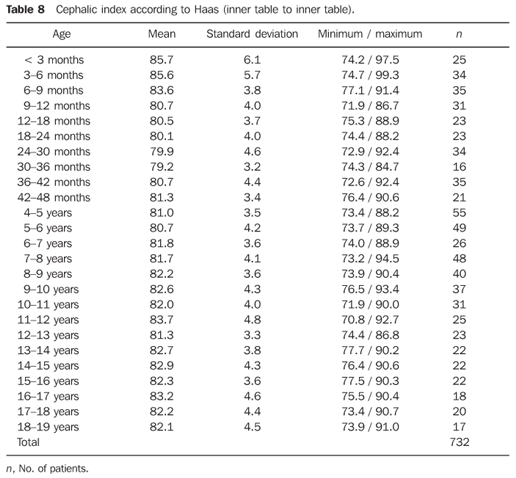Radiologia Brasileira - Publicação Científica Oficial do Colégio Brasileiro de Radiologia
AMB - Associação Médica Brasileira CNA - Comissão Nacional de Acreditação
 Vol. 41 nº 4 - July / Aug. of 2008
Vol. 41 nº 4 - July / Aug. of 2008
|
ORIGINAL ARTICLE
|
|
Radiological determination of cranial size and index by measurement of skull diameters in a population of children in Brazil |
|
|
Autho(rs): Inês Minniti Rodrigues Pereira, Antônio de Azevedo Barros Filho, Beatriz Regina Alvares, Evanisi Teresa Palomari, Lívio Nanni |
|
|
Keywords: Cranial diameters, Cranial size, Cranial index, Childhood, Radiography |
|
|
Abstract:
IPhDs, Assistant Professors, Department of Radiology at Faculdade de Ciências Médicas da Universidade Estadual de Campinas (FCM-Unicamp), Campinas, SP, Brazil
INTRODUCTION The radiological determination of cranial diameters in the childhood is relevant for evaluating the skull development in the pediatric and neuropediatric clinical practice. Based on these diameters, it is possible to establish development and growth alterations, especially in the first years of life. Studies developed by MacKinnon et al.(1), Taveras & Wood(2), Gordon(3), Cronqvist(4), Austin & Gooding(5), Gooding(6), and Haas(7) have described radiographic indices for cranial and brain sizes based on skull diameters, and correlated with age range and sex. The present study was based on the study developed by Haas, considering its highest relevance. However, it is important to note that the mentioned studies have evaluated a non-Brazilian population, in countries with low ethnic diversity, with higher socioeconomic development, and without an appropriate statistical analysis. Some of these studies lack data about the casuistic, sampling process, and evaluation of variability. The radiological evaluation of the cranial size should be based on the skull diameter, considering that malnutrition, genetic diseases, endocrine disorders and encephalic diseases are responsible for a series of systemic changes, some of them causing retardation, and others, an abnormal skull development(2,8,9). The cranial volume presents a four-fold increase between the birth and the adulthood, while the volume of the craniofacial region increases about 12 times(6,10). Additionally, 80% of the postnatal skull growths occur along the first three years of life(11–14). When the cranial index approaches the normality threshold, even in the setting of clinical neurological alterations, a plain radiological investigation may fail to detect abnormalities in the encephalic parenchyma, especially in cases where the closure of sutures and fontanelles is completed. For this reason, other diagnostic methods, such as computed tomography, should be utilized for evaluating the brain. According to Moss & Young(15), Dorst(16) and Momose(17), the child's skull is a dynamic structure as a function of two factors affecting the skull development: the skull contents and the sutures which undergo progressive accommodation. Abnormal brain growth or early fusion of sutures results in alterations in the cranial size, affecting the encephalic parenchyma. Radiography can be extremely useful in the assessment of the skull development, but it should be avoided for involving ionizing radiation; therefore a longitudinal radiographic study of the normal cranial growth cannot be performed. The present study was aimed at measuring skull diameters obtained by radiological methods, and calculating the cranial index and cranial size in Brazilian children with indication for radiological investigation because of cranial trauma, with no sign of fracture.
MATERIALS AND METHODS The present study evaluated a total of 1464 radiographs of 732 patients (428 male and 304 female) ranging in age from neonates to 18 years, with previous indication for cranial radiography for cranial traumatism. All the patients answered to an inclusion questionnaire about neuropsychomotor development and previous history of diseases, and so inclusion criteria were established. None of the patients presented any physical or cranial disease. The conventional methodology was adopted for acquisition of posteroanterior, anteroposterior and lateral views, with a 1 m source-film distance. After images acquisition, skull diameters were measured. The fronto-occipital diameter (FO) is the measurement of the major distance between the extreme points of the frontal and occipital lobes, and skull length (L) is the major measurement perpendicular to the skull base line, i.e., the line parallel to the sphenoid sinus floor to the posterior margin of the magnum foramen, for measurements from inner table to inner table (Figure 1A). The biparietal diameter (BP) is the major measurement between parietals, from inner table to inner table (Figure 1B).
Measurements of skull diameters were evaluated by three radiologists and statistical analysis involved paired comparisons of mean diameters. No significant variation was found in relation to the method utilized (p > 0.05) (Table 1).
After the measurement of skull diameters of the 732 patients, Tables were prepared with mean values and standard deviation for fronto-occipital and biparietal diameters, and cranial length, according to age range and sex. A comparative analysis of the variables for each age range and according to sex was performed utilizing the Student's t-test for independent samples both for measurements from inner-table to inner table and from outer table to outer table. After the data analysis, the authors opted for the measurements from inner table to inner table for demonstrating a closer proximity between the skull and brain growths. Cranial index and size calculation was based on equations proposed by Haas, where the cranial index corresponded to the division of the width by the length transformed into percentages, and the cranial size, to the average of the three diameters, as follows:
RESULTS The comparative study of mean skull diameters in both sexes and according to ages, based on inner measurements is demonstrated on Tables 2, 3 and 4, where a more accelerated development in the first year, and a slower development as from the second year of life can be observed in both male and female children. It can be observed that the increase in the fronto-occipital diameter is lower in female than in male children, but mean values remain proportional for both sexes in the first year as well in the subsequent years of life, with no statistical significance.
No significant difference is found in overall mean diameters between male and female individuals in the paired mean diameters comparison by the Student's t-test. After the measurement of skull diameters, cranial index and size were calculated and included respectively on Tables 5 and 6, based on the cranial module and cephalic index proposed by Haas(7), by measurements from inner-table to inner-table.
Based on the values found in the present study, the authors observed a marked decrease in the mean value for cranial index in the first year of life, and a milder decrease in the age range between four and five years, and stabilizing thereafter, as shown on Table 5 as compared with Table 7 in the study developed by Haas(7). This is explained by the fact that, after the first year of life, the cranial index is not connected with the age, partially because the fronto-occipital diameter increases more rapidly than the other diameters, as shown on Table 2. On the other hand, the cranial size or cranial module of Haas(7) corresponds to the average of the sum of the three diameters measured from inner-table to inner-table, and increases as the diameters. In the first year of life, mean values present a higher increase, and later, a lower increase up to the age of four, stabilizing thereafter up to the age of 18, as shown on Table 6 as compared with Table 8.
DISCUSSION Amongst the studies considered for comparison with the results of the present study, the one developed by Haas(7), evaluating the cephalic index and cranial module, has presented the most satisfactory results in the comparative data analysis. Based on the measurements of skull diameters performed in the present study, the authors could observe that some cranial indices are good indicators of the skull growth and can be utilized in the follow-up of the cranial development. Computed tomography is undoubtedly an excellent method for encephalic evaluation, but is ineffective in the follow-up of the skull development, considering the impossibility of determining the same positions and sizes of all structures involved for measurement of cranial diameters(9,12). Regarding the history of the skull growth, Haas(7) has studied 1427 European patients ranging in age from neonates to 21 years, included in a sample slightly larger than the samples of the other mentioned studies, but with no miscegenation. The author has utilized a 97.0 cm source-film distance, while the recommended distance is 100 cm. Haas does not report the positioning of the skull for images acquisition, and mentions the central ray angulation in relation to the imaged skull. Additionally, his sample for the first year of life (when the skull growth is more accelerated) includes 23 patients, while the skull diameters determined in the present study refer to a sample including 62 patients in their first year of life, justifying a larger sample size, indicating more reliable measurements and statistical evaluations. The skull growth is quite accelerated in the first year of life, as demonstrated by the increase in cranial diameters on the tables included in the present study. Changes in the cranial diameters slow down after the first three years of life, and are associated with a 25% increase in the encephalic weight, according to MacKinnon et al.(1). The comparison between cranial indices calculated in the present study and the one developed by Hass(7) demonstrated practically the same result, with no statistical significant difference. However, our study presented a larger casuistic, a better ethnic diversity, and better statistical analysis. These indices are not useful in the evaluation of a possible encephalic involvement, but rather to follow-up the cranial development.
CONCLUSION The cranial index evaluated in the present study is a good indicator of the skull growth, especially in the first four years of life, when the skull grows more rapidly. After this age, considering the decrease and stabilization in the growth velocity and the decreased statistical value, the cranial size or tables with skull diameters become better indicators for following-up the skull development both in female and male individuals.
REFERENCES 1. MacKinnon IL, Kennedy JA, Davis TV. The estimation of the skull capacity from roentgenologic measurements. Am J Roentgenol Radium Ther Nucl Med. 1956;76:303–10. [ ] 2. Taveras JM, Wood EH. Cráneo. In: Taveras JM, Wood EH, editores. Diagnóstico neuroradiológico. Buenos Aires: Editora Panamericana; 1968. p. 146–7. [ ] 3. Gordon IRS. Measurement of cranial capacity in children. Br J Radiol. 1966;39:377–81. [ ] 4. Cronqvist S. Roentgenologic evaluation of cranial size in children. Acta Radiol Diagn (Stockh). 1968;7:97–111. [ ] 5. Austin JH, Gooding CA. Roentgenographic measurement of skull size in children. Radiology. 1971;99:641–6. [ ] 6. Gooding CA. Skull vault: size and shape. In: Newton TH, Potts DG, editors. Radiology of the skull and brain. St. Louis: CV Mosby; 1971. p. 61–93. [ ] 7. Haas LL. Roentgenological skull measurements and their diagnostic applications. Am J Roentgenol Radium Ther Nucl Med. 1952;67:197–209. [ ] 8. Meredith HV. Growth in head width during the first twelve years of life. Pediatrics. 1953;12:411–29. [ ] 9. Swischuk LE. Radiologia do recém-nascido do lactente e da criança pequena. Rio de Janeiro: Guanabara Koogan; 2006. [ ] 10. Moss ML, Greenberg SN. Postnatal growth of the human skull base. Angle Orthodontist. 1955;25: 77–84. [ ] 11. Shapiro R, Janzen AH. The normal skull. A roentgen study. New York: Paul B. Hoeber; 1960. [ ] 12. Sullivan PG. A method for the study of jaw growth using a computer-based three-dimensional recording technique. J Anat. 1972;112(Pt 3):457–70. [ ] 13. Watson EH, Lowrey GH. Growth and development of children. Chicago; Year Book Medical Publisher; 1967. [ ] 14. Tanner JM. Some notes on the reporting of growth data. Hum Biol. 1951;23:93–159. [ ] 15. Moss ML. Vertical growth of the human face. Am J Orthodontics. 1964;50:359–76. [ ] 16. Dorst JP. Functional craniology: an aid in interpreting roentgenograms of the skull. Radiol Clin North Am. 1964;2:347–66. [ ] 17. Momose KJ. Developmental approach in the analysis of roentgenograms of the pediatric skull. Radiol Clin North Am. 1971;9:99–116. [ ] Received October 4, 2007. Accepted after revision December 4, 2007. * Study developed in the Department of Radiology at Faculdade de Ciências Médicas da Universidade Estadual de Campinas (FCM-Unicamp), Campinas, SP, Brazil. |
|
Av. Paulista, 37 - 7° andar - Conj. 71 - CEP 01311-902 - São Paulo - SP - Brazil - Phone: (11) 3372-4544 - Fax: (11) 3372-4554
